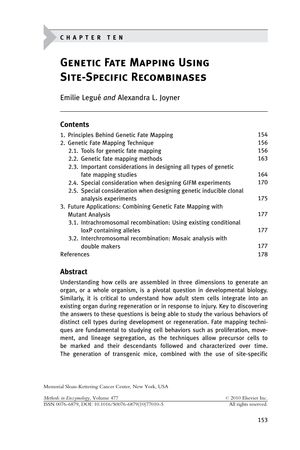Genetic Fate Mapping Using Site-Specific Recombinases
January 2010
in “
Methods in Enzymology
”

TLDR The document concludes that careful design of genetic fate mapping experiments is crucial for accurate cell lineage tracing in mice.
The document from 2010 details the use of genetic fate mapping with site-specific recombinases (SSRs) to trace cell lineages in mice, focusing on the methodology and considerations for successful experiments. It explains the use of SSRs like Cre and Flp recombinases, which are activated by ligands such as tamoxifen, to induce recombination at specific DNA sequences in reporter alleles, allowing for temporal control over cell marking. The document discusses various fate mapping techniques, including cumulative, inducible, clonal, and intersectional methods, and the importance of selecting appropriate promoters and reporter alleles for specific cell populations. It also addresses the potential toxicity of SSRs and ligands, the variability in recombination efficiency, and the need to test for noninduced labeling. Techniques like the Brainbow system and Mosaic Analysis with Double Markers (MADM) are mentioned for their ability to distinguish multiple recombination events and to study mutant cell fates within a wild-type environment. The document emphasizes the need for careful experimental design, including the choice of SSR and reporter allele, the genetic background of the mice, and the administration of ligands, to ensure accurate and robust cell lineage tracing.
